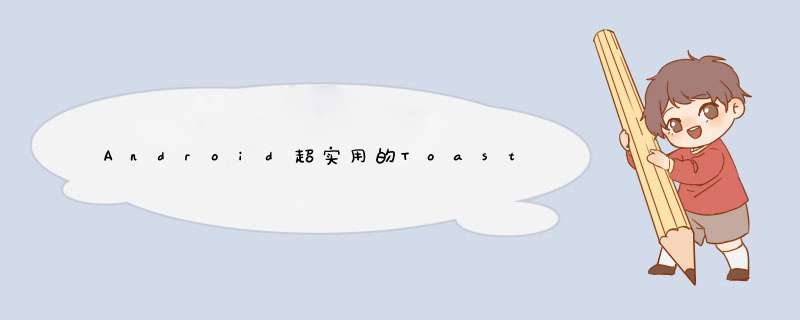
前言
相信每位AndroID开发者都用过Toast,都知道是d出消息的。类似于Js里面的alert,C#里面的MesageBox。当然androID里面也有dialog,dialog是有焦点的,可与用户交互。而toast是没有焦点的,时间到了自动消失,不能回应用户的交互,下面就跟大家分享下AndroID中Toast提示框的优化方法。
先看下源码:
public class Toast { public static final int LENGTH_SHORT = 0; public static final int LENGTH_LONG = 1; /** * 构造一个空的toast。你必须在调动show()之前,线调用setVIEw() * @param context 参数,application或者activity都可以 */ public Toast(Context context) { ... //获取系统内置的toast_y_offset常量值 mTN.mY = context.getResources().getDimensionPixelSize( com.androID.internal.R.dimen.toast_y_offset); mTN.mGravity = context.getResources().getInteger( com.androID.internal.R.integer.config_toastDefaultGravity); } /** * 在指定的时长显示vIEw视图 */ public voID show() { //如果mNextVIEw为空,即没有设置vIEw if (mNextVIEw == null) { throw new RuntimeException("setVIEw must have been called"); } //通过系统服务,获取通知管理器。看来这是使用系统通知? Inotificationmanager service = getService(); String pkg = mContext.getopPackagename(); TN tn = mTN; tn.mNextVIEw = mNextVIEw; try { service.enqueuetoast(pkg,tn,mDuration); } catch (remoteexception e) { // Empty } } /** * 关闭一个正在显示的toast,或者取消一个未显示的toast. * 通常你不必调用它,在适当的时长后它会自动消失的。 */ public voID cancel() { mTN.hIDe(); try { getService().cancelToast(mContext.getPackagename(),mTN); } catch (remoteexception e) { // Empty } } /** * 设置toast显示的视图内容,不单单是黑色的界面,你可以自己决定显示什么 * @see #getVIEw */ public voID setVIEw(VIEw vIEw) { mNextVIEw = vIEw; } /** * 设置时长,只能是下面这两个常量值,没什么卵用 * @see #LENGTH_SHORT 2000毫秒 * @see #LENGTH_LONG 3500毫秒 */ public voID setDuration(@Duration int duration) { mDuration = duration; } /** * 设置vIEw的外间距,不用多说. * * @param horizontalmargin The horizontal margin,in percentage of the * container wIDth,between the container's edges and the * notification * @param verticalmargin The vertical margin,in percentage of the * container height,between the container's edges and the * notification */ public voID setmargin(float horizontalmargin,float verticalmargin) { mTN.mHorizontalmargin = horizontalmargin; mTN.mVerticalmargin = verticalmargin; } /** * 设置notification在屏幕中的方位,大家都知道.上中下左中右什么的都有 * @see androID.vIEw.Gravity * @see #getGravity */ public voID setGravity(int gravity,int xOffset,int yOffset) { mTN.mGravity = gravity; mTN.mX = xOffset; mTN.mY = yOffset; } /** * 构造一个只包含一个TextVIEw的标准toast对象 * * @param context 通常是application或者activity对象 * @param text 用于显示的文本,可以是formatted text. * @param duration 显示时长. LENGTH_SHORT或LENGTH_LONG * */ public static Toast makeText(Context context,CharSequence text,@Duration int duration) { Toast result = new Toast(context); LayoutInflater inflate = (LayoutInflater) context.getSystemService(Context.LAYOUT_INFLATER_SERVICE); //包含了一个默认的TextVIEw,这个textvIEw的布局位置在 com.androID.internal.R.layout.transIEnt_notification,可以去查看下内容 VIEw v = inflate.inflate(com.androID.internal.R.layout.transIEnt_notification,null); TextVIEw tv = (TextVIEw)v.findVIEwByID(com.androID.internal.R.ID.message); tv.setText(text); result.mNextVIEw = v; result.mDuration = duration; return result; } /** * 更新通过makeText()方法创建出来的toast对象显示的文本内容 * @param s 待显示的新文本内容. */ public voID setText(CharSequence s) { if (mNextVIEw == null) { throw new RuntimeException("This Toast was not created with Toast.makeText()"); } /** * 看来com.androID.internal.R.layout.transIEnt_notification布局里面的唯一的 * TextVIEw标签的ID是R.ID.message。拿到这个textvIEw,设置新文本内容 */ TextVIEw tv = (TextVIEw) mNextVIEw.findVIEwByID(com.androID.internal.R.ID.message); if (tv == null) { throw new RuntimeException("This Toast was not created with Toast.makeText()"); } tv.setText(s); } static private Inotificationmanager getService() { if (sService != null) { return sService; } //获取远程的通知服务 sService = Inotificationmanager.Stub.asInterface(ServiceManager.getService("notification")); return sService; } //TN是一个瞬态通知的子类,里面包含显示和隐藏两个任务对象 private static class TN extends ITransIEntNotification.Stub { final Runnable mShow = new Runnable() { @OverrIDe public voID run() { handleShow(); } }; final Runnable mHIDe = new Runnable() { @OverrIDe public voID run() { handleHIDe(); // Don't do this in handleHIDe() because it is also invoked by handleShow() mNextVIEw = null; } }; //出现Handler了哦 final Handler mHandler = new Handler(); /** * 调度handleShow任务到执行线程中 */ @OverrIDe public voID show() { if (localLOGV) Log.v(TAG,"SHOW: " + this); //handler发送异步任务了 mHandler.post(mShow); } /** * 同上 */ @OverrIDe public voID hIDe() { if (localLOGV) Log.v(TAG,"HIDE: " + this); mHandler.post(mHIDe); } //... } } 通过上面的源码解读,了解到有远程通知,handler异步任务等信息,不多说,自己看。
重点是toast的用法:
1、直接调用makeText静态方法即可,返回的是Toast对象,最后别忘了调用show方法显示:
Toast.makeText(context,text,duration).show();
或
Toast toast = Toast.makeText(context,duration); pre name="code" > toast.setVIEw(vIEw); toast.setText(s); toast.setGravity(gravity,xOffset,yOffset); toast.setDuration(duration); toast.show();
2、还可以使用new的方式创建,别忘了setVIEw()方法:
Toast toast = new Toast(); toast.setVIEw(vIEw); toast.setText(s); toast.setGravity(gravity,yOffset); toast.setDuration(duration); toast.show();
以上这些都不值得一提,很简单。
在开发过程中,有这样的需求:在项目总,我们偷懒,想连串toast出多个变量的值或者其他任务,可在 *** 作手机时直观可见。问题来了,d出是无论我们的 *** 作有多快,这些toast内容都是一个跟着一个显示,没办法快进。哪怕我们玩完了,退出了app,它还在d。怎么办?有没有办法让toast的内容与我们的 *** 作同步,快速反应?
public class T { private static Toast toast; public static voID show(Context context,String msg) { if (toast == null) { toast = Toast.makeText(context,msg,Toast.LENGTH_SHORT); } else { toast.setText(msg); } toast.show(); } } 单例模式,每次创建toast都调用这个类的show方法,Toast的生命周期从show开始,到自己消失或者cancel为止。如果正在显示,则修改显示的内容,你持有这个对象的引用,当然可以修改显示的内容了。若每次你都makeText或者new一个toast对象,即每次通过handler发送异步任务,调用远程通知服务显示通知,当然是排队等待显示了。
结束语
以上就是AndroID中Toast提示框优化的全部内容,希望对大家开发AndroID能有所帮助,如果有大家有疑问可以留言交流。
总结以上是内存溢出为你收集整理的Android超实用的Toast提示框优化分享全部内容,希望文章能够帮你解决Android超实用的Toast提示框优化分享所遇到的程序开发问题。
如果觉得内存溢出网站内容还不错,欢迎将内存溢出网站推荐给程序员好友。
欢迎分享,转载请注明来源:内存溢出

 微信扫一扫
微信扫一扫
 支付宝扫一扫
支付宝扫一扫
评论列表(0条)